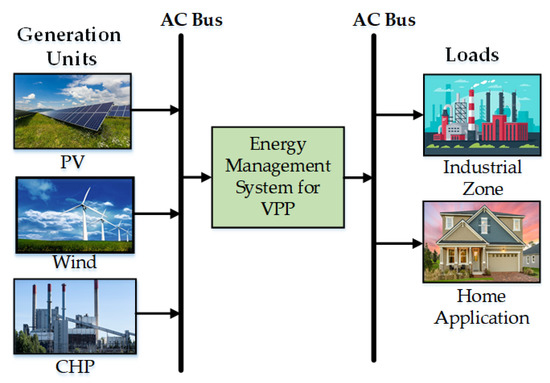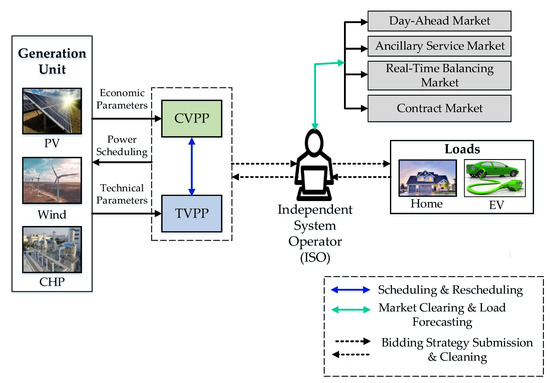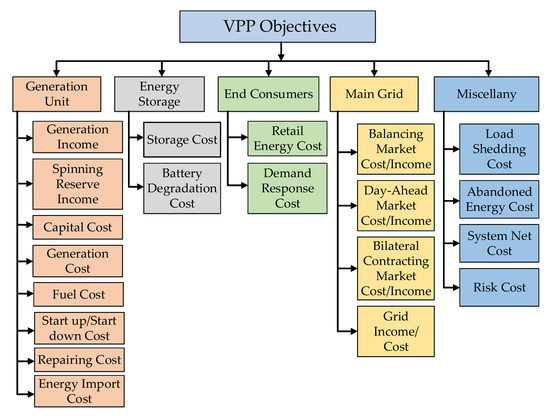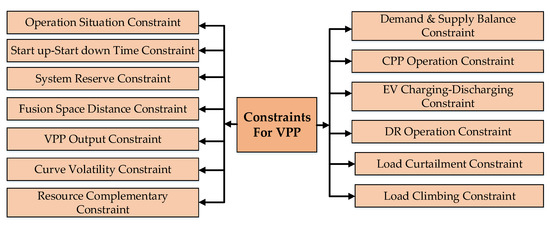Due to the rapid growth in power consumption of domestic and industrial appliances, distributed energy generation units face difficulties in supplying power efficiently. The integration of distributed energy resources (DERs) and energy storage systems (ESSs) provides a solution to these problems using appropriate management schemes to achieve optimal operation. Furthermore, to lessen the uncertainties of distributed energy management systems, a decentralized energy management system named virtual power plant (VPP) plays a significant role.
- virtual power plants
- digital electricity
- optimization strategies
- distributed energy resources
- renewable energy resources
- energy management
- energy scheduling
- distributed generation
- real-time energy markets
- electricity market
- demand response
- optimization in
1. Introduction
The increasing demand for power in the electricity market and adverse effects in the environment introduce distributed energy resources (DERs) as the alternative to the conventional power generation system. The traditional generation of power uses fossil fuels (oil, gas), which emit toxic gases and affect the environment. Conventionally, generation units focus on only the ‘connection’ concept to the transmission system to distribute power to the energy market. The conventional generation term is replaced by the virtual power plant (VPP) concept, which integrates DERs rather than making connections [1,2,3]. The idea of VPP was first proposed in 1997 by Shimon Awerbuch that integrates DERs to ensure efficient power distribution with minimum cost [4]. Distributed generation (DG) units are usually found near the distribution networks with some characteristics such as decentralization, small generation units, etc. DERs include both the generation units as well as energy storage units [5]. Two types of DG are available such as renewable energy resources (RERs) and fuel-based energy resources. RERs present photovoltaic (PV), wind power plants, and so on, whereas fuel-based energy represents micro-turbine, fuel cell, and internal combustion engine generator as the generation units. Several distribution networks are implemented in recent times with DERs, including long-term and short-term operations [6,7,8,9,10,11,12]. To cope with the massive electricity demand, DERs operation seems to be quite tricky. Hence, a reliable solution should be implemented to overcome these difficulties and uncertainties. VPP acts as a sustainable solution for the optimal operation of DERs and smooth power distribution to the loads. VPP presents a platform to aggregate all the DERs that promote system visibility and governance of the power management system and ensure better interactions among the system’s different components. VPP proposes a decentralized platform and energy-efficient management scheme for DERs [13]. VPP considers environmental effect, commercial efficacy, and day-ahead scheduling for optimal operation of DERs and fulfills load demand. VPP emphasizes more on eliminating uncertainties that arise due to market prices, load demand, and power distribution networks.
VPPs are of two kinds: commercial VPP (CVPP) and technical VPP (TVPP). CVPP focuses on the power system’s economic aspects to minimize system cost with the highest profits. It considers present load demand in the electricity market and uses appropriate methods to determine the future load demand. It also observes the probable risk conditions and imbalances in the system. On the other hand, TVPP collects different information from CVPP, such as DERs maximum capacity, future load demand, and so on, to take the proper steps for VPP. TVPP computes data of different parameters of DERs to observe the system efficacy.
Active control between DERs and flexible loads in VPP, considering economic, technical, and environmental aspects, is demonstrated in [14]. The paper intends to efficiently integrate generation units to smart grids and maintain voltage, load management, and short-circuit protection. Germany considers the VPP as an alternative energy system [15]. This paper analyzes different aspects of VPP and explores the potential feasibility of using VPP with modern technology. The intelligent control and the integrated computer system are utilized to reduce greenhouse gases [16]. Hence, Fuzzy logic control (FLC) is adopted to achieve high-level feasibility. The optimal operation can be attained by addressing the intelligent concept of VPP. Nikonowicz et al. [17] presents a comprehensive analysis of different VPP concepts depending on several aspects such as infrastructure, control scheme, and verification platform. It provides a correlative idea to characterize them in terms of economic and technical efficacy. OpenADR 2.0b communication protocol contributes to developing a secure and reliable VPP system [18]. An Internet-based communication system facilitates the transmission system operator (TSO), and numeric simulation verifies different operating conditions of VPP. Mahmud et al. [19] introduces the ‘Internet of Energy (IoE)’ concept that aggregates DERs and flexible loads. This paper analyzes the IoE concepts and compares them with the conventional control scheme to justify the reliability. The relative analysis includes the VPP structure, control system, economic and technical feasibility. However, this concept cannot provide a solution to remove uncertainties, economic dispatch, and communication delay.
Software integration with VPP is developed in [20] that provides information and communication technology (ICT) based control for DERs to loads and facilitates electric vehicle (EV) charging purposes. A comparative review of different VPP is provided in [21] based on optimization feasibility, technical and economic aspects, security, data, and intelligent management platform. The European FENIX project for VPP is presented in [22] that analyzes each CVPP depending on marginal cost, computed data, and forecasting data. Integration between distribution system operator (DSO) and transmission system operator (TSO) is also established. Furthermore, a VPP system is proposed in [23] to satisfy the emergency power demand in South Korea that integrates different generation units. The proposed scheme considers only economic feasibility: to maximize the profits at a low cost. California test method is employed to verify financial reliability. However, the scheme does not consider the technical and environmental benefits. A comparative analysis of the business model (BM) for VPP in different countries (American, German, Australian, Danish, and Finnish) are introduced in [24] that presents several unique characteristics of each countries BM. The generated energy is distributed in the electricity market, and distributors need to follow the rules and regulations to sustain the electricity market’s economic benefits. For this purpose, different BM policies have been established. This paper also reviews the business model of Poland based on economic and political aspects.
The potentiality of combined heat and power (CHP) can be utilized with VPP to generate more power and fulfill the power demands [25]. It analyzes the amount of power and gas consumption and presents a BM to optimally operate and distribute power in the energy market based on the technical aspects. Generic VPP based on service-oriented architecture (SOA) is demonstrated in [26] where software and communication-based technology is employed to attain the technical feasibility and environmental benefits and distribute power to the consumers at a low cost. An analysis of VPP is presented in [27] based on the technical aspects that provide an efficient power distribution among the generation and grids. The study determines the real-time values of the different parameters in the power distribution system. It formulates a notion about the number of DERs and ESS that can be optimally connected to VPP based on the technical and economic aspects. A detailed analysis of uncertainties in VPP is carried out in [28] that is mainly based on three factors: renewable power, load demand, and market price. A comprehensive analysis of the three aspects of uncertainties is presented, and the process of lessening the uncertainties is demonstrated. Etherden et al. [29] shows the common information model (CIM) power utility standard and supervisory control and data acquisition (SCADA) to fulfill the communication and functional requirements for VPP. A relative analysis of different VPP based on flexible loads, generation units, distribution factors is presented in [30]. Moreover, they also provided a detailed analysis of technical VPP and commercial VPP. The possibility of optimal CHP integration with VPP and demand response in the electricity market is also discussed. An intelligent identification and fault diagnosis in a large-scale power plant is proposed in [31], based on a multi-agent system (MAS). The MAS concept can be adapted to the VPP system to achieve efficient power distribution and intelligent identification. A µ-CHP unit acts as an alternative source in VPP during the large power demand [32]. A comprehensive analysis of hierarchical system with VPP regarding control, market policies, and storage capabilities are presented in [33]. Also, they discuss different control strategies based on communication and intelligent governance for the smart grid with storage capability. However, the authors in Ref [33] does not provide any BM idea to develop economic competence in the electricity market. Pal et al. [34] presents a comparative analysis of different optimization schemes and the best optimization scheme is chosen based on different aspects: VPP sizing, costing, environmental feasibility, transmission loss, and uncertainties.
2. Virtual Power Plants
VPP proves itself as the alternative to the conventional transmission-based power generation plant. Conventional generation plants (CGPs) have some aspects that are needed to be followed, such as the schedule of generation, limits of the number of generations, power losses, the relationship between demand and availability of power, and so on. CGP generally integrates different DERs that follow a specific power management system. Lack of proper management in CGP results in inefficient power management with less technical and economic feasibility. VPP is the representation of integrating different DERs that overcomes the barrier of CGP by creating a single operating platform with the available generation and distribution units, as shown in Figure 3.

Figure 3. An overview of VPP consists of several generations and distribution units and is managed by an appropriate energy management system (Note: AC-alternating current; DC-direct current; PV-photovoltaics; VPP-virtual power plants; CHP-combined heat and power).
VPP considers different parameters to operate, such as schedule of generation and distribution, power demand concerning generation, voltage regulation capability, consumer behavior, cost-efficacy, and so on. VPP utilizes DERs to ensure the optimal power flow among the sources and fulfill the electricity market [1]. VPP introduces flexible cooperation between energy distribution strategies and market demand response feasibility. It focuses on creating a mathematical combination of DERs to present a reliable power management system. VPP can be expressed as ‘Energy Internet Hub’ as it can be controlled and operated by the wireless technology sitting in a remote position [35]. A generalized framework of VPP is illustrated in Figure 4, which indicates that VPP focuses on different aspects that provide optimal power distribution and fulfills demand response to the electricity market.

Figure 4. A basic framework of virtual power plant consisting of distributed energy resources. (Note: PV-photovoltaics; CHP-combined heat and power; CVPP-commercial virtual power plant; TVPP-technical virtual power plant; EV-electric vehicle).
2.1. Commercial Virtual Power Plant
CVPP mainly emphasizes financial aspects in the electricity market that intends to maximize the profits with minimum system cost. CVPP integrates different DERs concerned with the precise marginal cost and the rational evaluation of energy market conditions [36].
The marginal cost is considered for the prior scheduling of renewable energy sources [37]. Numerous DERs from different locations are integrated through CVPP and can be maintained by the operator sitting at any geographical location. CVPP determines the electricity market’s current load demand and previous information to utilize DERs in the energy market. It reduces the imbalance and risks from the system and introduces high efficiency with minimum cost.
2.2. Technical Virtual Power Plant
TVPP observes system management of a VPP that engages several DERs and ESSs. It facilitates the optimal operation of DERs and considers the marginal cost of the system. It mainly focuses on monitoring the activities of DERs that are connected with local networks to fulfill the load demand in the electricity market. TVPP determines the values of different technical parameters and real-time data to ensure the optimal operation and management of the VPP. It provides a secure and safe way of process and maintains a better connection with CVPP. TVPP collects different information from CVPP, such as the maximum capacity of each DERs and ESSs, forecasted values of future requirements, the geographical locations of each DERs and ESSs, available control strategies of the system, and so on [38]. According to this information, TVPP takes some necessary steps to run the optimal operation of VPP.
2.3. Objective Functions and Constraints
VPP integrates DERs, ESSs, and flexible loads that consider specific objective functions to maintain the optimal operation. The objective functions mainly focus on maximizing system profits and benefits with minimum cost. Figure 5 presents different objective functions of VPP in terms of various aspects, such as generation unit, main grid, energy storage, end consumers, and so on.

Figure 5. A classification of different optimization objectives of the virtual power plant (VPP).
The generation unit depicts four objective functions: generation income, capital cost, operational cost, and spinning reserve income. Capital cost [39,40,41,42,43,44,45,46] and operational cost [28,33,42,43,44,47,48,49,50,51,52,53,54,55,56,57,58,59,60,61,62,63,64] provides the cost of generation, where the generation income [33,48,50,62,63] from electricity market and spinning reserve income [47,51,52,53,54] compensate the cost. The main grid includes balancing market income/cost [43,46,52,53,54,57,58,61,64] that balances among different sections in the electricity market such as consumers, distributors, effects, etc. Bilateral contracting cost/income [36,48,55,56] is another objective function of the main grid representing a contract among consumers, producers, and distributors regarding power distribution in the electricity market. The main grid presents day-ahead market cost/income [41,45,50,51,53,54,56,64] as another objective function that deals with day-ahead market scheduling in the electricity market. Storage cost [33,36,43,48,51] acts as an objective function of energy storage that considers the cost of storing energy in storage devices. The effect of battery degradation affects the cost of energy storage in the battery, and hence battery degradation cost [44] acts as an objective function of energy storage. There is a cost for end consumers to consume retail energy and consider demand response in the electricity market. Hence, end customers consider retail energy cost [42,43,45,47,49,51,55,56,59] and demand response cost [33,36,43,45,47,48,49,50,51,59,62] as objective function. Figure 5 also illustrates some other objective functions, such as load shedding cost [48], risk cost [36,40,44,53,54], abandoned energy cost [62], and system net load cost [33].
Figure 6 demonstrates the different constraints for VPP that concern the optimal operation of VPP in the energy market. The demand and supply balance constraints consider supply and distribution networks’ cooperation to attain the consumers’ satisfaction. Fusion space distance constraints provide a specific range to maintain the optimal operation [65]. VPP output constraint presents an output range that indicates maximum and minimum output level. Curve volatility constraint demonstrates the volatility of the curve that maintains curve feasibility and system stability. Resource complementary constraint focuses on eliminating the uncertainties from the system and on improving resilience. Consumers follow startup-start downtime constraints when the price of electricity is changed, and time is needed to adjust the change. Operation situation constraint provides the idea to undertake the scheduling in terms of demand response of consumers. Load curtailment constraint and load climbing constraint consider consumer’s load demand and ensure satisfaction. Demand response (DR) operation constraint and conventional power plant (CPP) operation constraint maintain the load demand and regard the consumer’s behavior in the electricity market schedule. EV charging-discharging constraint provides a period for charging and discharging the EV. System reserve constraint implies the consumer’s power reservation instead of power consumption [66].

Figure 6. A representation of different constraints for virtual power plant optimization. (Note: VPP-virtual power plant; CPP-conventional power plant; EV-electric vehicle; DR; demand response).
3. Conclusions and Future Directions
To improve the VPP technology, researchers have proposed several optimization schemes. Selecting a proper optimization scheme from existing methods to apply in a specific VPP field seems quite tricky. Therefore, this paper profoundly analyzes 65 control strategies in terms of optimization techniques, advantages and disadvantages, computational time, economic and technical efficacy, and accuracy. Furthermore, a comparative study is also done among the classified seven types of optimization algorithms, techniques, and methods for VPP that concern the technical and economic efficacy of the system.
The significant findings from the analysis are illustrated as follows:
-
The offering strategy that utilizes wind power and demand responses overcomes the intermittence problem in the electricity market. The system also balances the electricity market prices with an improving profit. A fast-computation can be achieved if the offering model is combined with stochastic programming.
-
Like fuzzy logic, intelligent control can maintain priority management among suppliers, consumers, and demand responses. Furthermore, a flexible smart grid can be established using MAS that includes ANN, level-based approach, and EVPP.
-
PBUC method utilizes DERs in DA market scheduling to handle uncertainties in the electricity market.
-
Bidding strategies (BSs) can maximize profits. The BSs with two-stage robust optimization can eliminate uncertainties along with maximizing profits. The security can also be ensured by BDT based BS.
-
DLC, based on linear programming, successfully handles both the transmission and distribution system. CCS can govern power in a broader range. Linear programming-based control maximizes profits as well as lessens risk.
-
Bi-level or multi-level stochastic optimization can deal with uncertainty parameters such as wind power generation, DA market scheduling, and ultimately provides maximum profits.
The analysis presents the probability of combining different techniques in a single strategy to attain optimal operation to distribute power in the electricity market. Moreover, the study analyzes different optimization schemes that enable the researchers to verify optimization strategy considering financial and technological reliability, computational time, and eliminating uncertainties. Analysis of the business model provides a notion to handle the electricity market by considering consumers’ behavior and demand responses. Optimization strategies that include more than one technique are also analyzed and demonstrated to perceive the feasibility. Overall, the authors believe that the systematic categorization presented in the review work would guide future enthusiasts to choose the proper optimization strategy for a specific application in this field.
VPP provides a flexible platform that can add or remove any of the power sources, but uncertainty results in the system operation. Future research can be extended to analyze uncertainties of VPP. An extensive exploration of day-ahead 24 h scheduling can be carried out to integrate VPP and power to gas technology. Dynamic load management and priority-based load management in microgrids should be analyzed. There should be comprehensive research to develop the efficacy of the combined operation of VPP and electric vehicle charging. IVPP (information VPP) provides different levels of information to the VPP operator. IVPP should be included in future research to represent the acceptability of the VPP optimization technique. Further research can be considered in the field of inductive charging and autonomous driving.
This entry is adapted from the peer-reviewed paper 10.3390/en13236251
